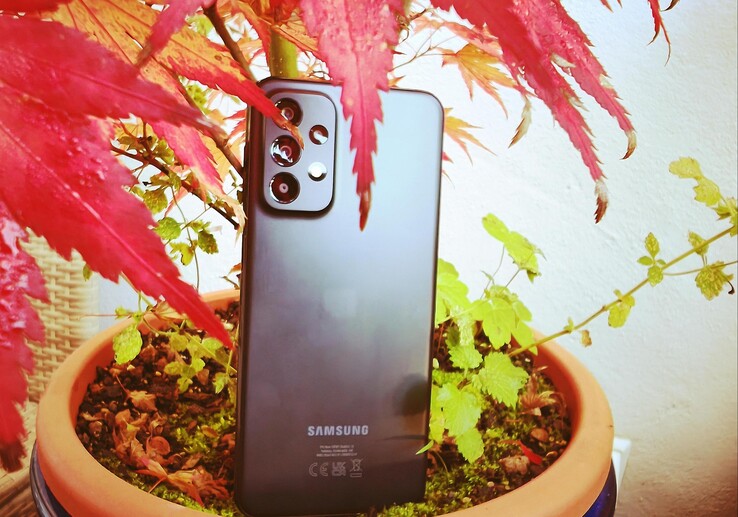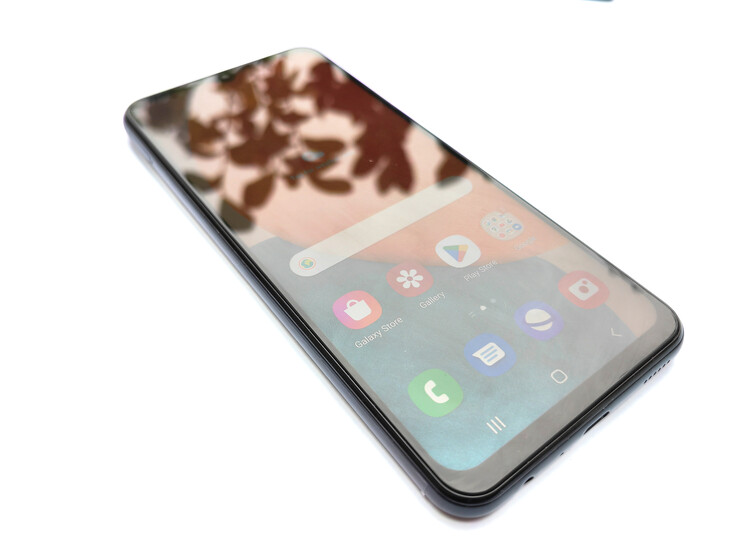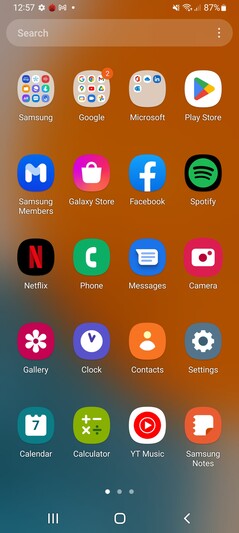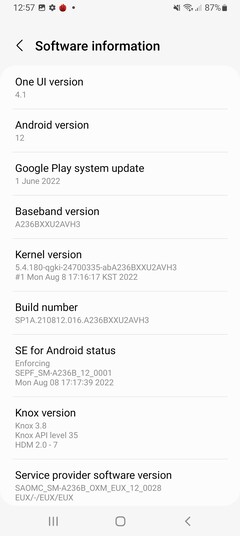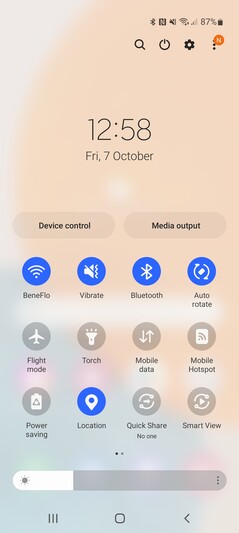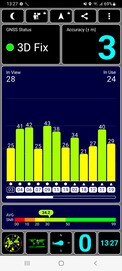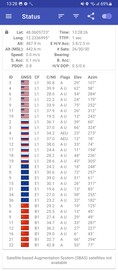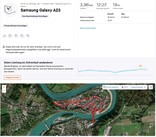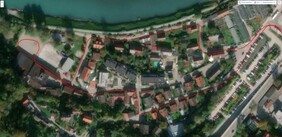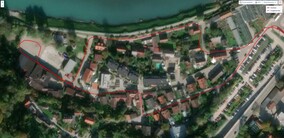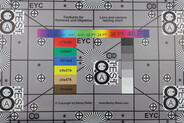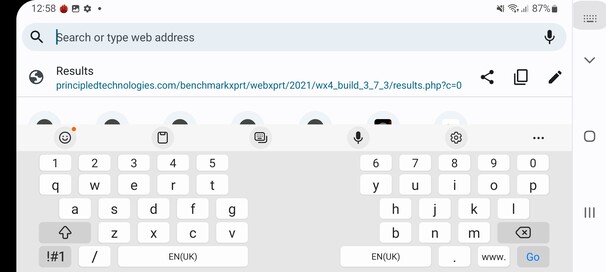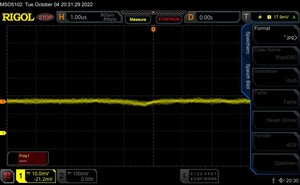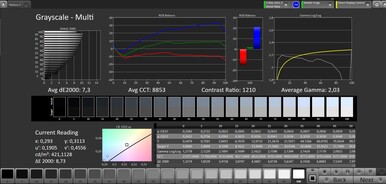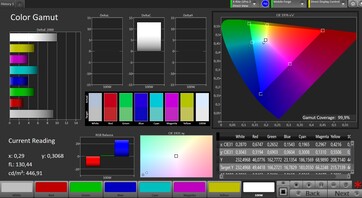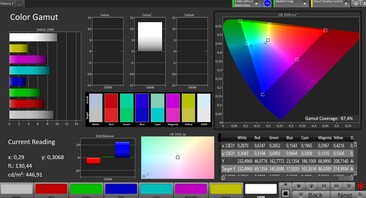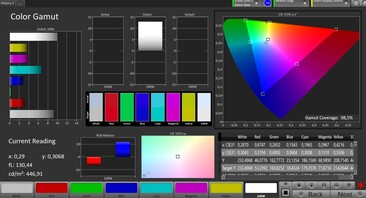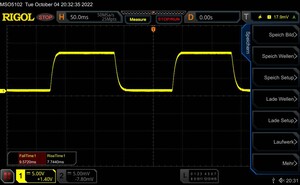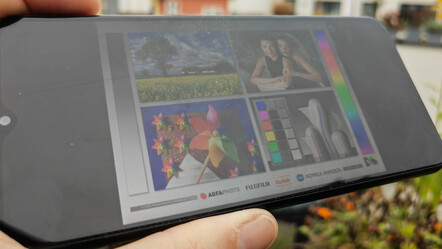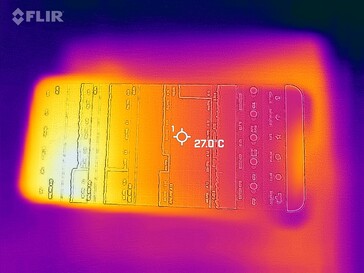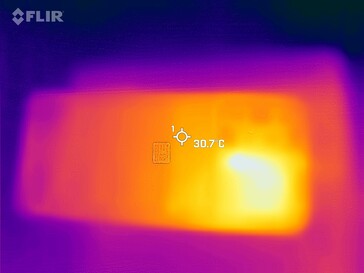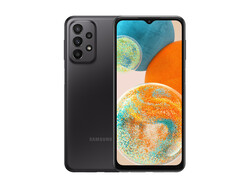Samsung Galaxy A23 5G smartphone review: Powerful mid-range phone with OIS camera
The Samsung Galaxy A23 5G is one of the more affordable 5G smartphones in Samsung's lineup. In Europe, the smartphone was only available in the 5G version at the time of review, although the Galaxy A22 predecessor is also offered as a 4G variant and the Galaxy A23 4G is also available internationally.
The manufacturer is asking US$ 244.99 for the 64 GB version of the Galaxy A23 5G. This is a significant price jump of around US$ 70 more than the predecessor, which consequently changes the category of comparison phones. In the meantime, the price of the predecessor has fallen even further: The Galaxy A22 5G can be purchased online for around US$ 188.50 at the time of review.
In our review, we take a closer look at whether the surcharge pays off in light of the device's improvements, or whether you should buy the predecessor.
Note for international readers (outside the German speaking region): Prices may vary widely from location to location and so may not correspond to the aforementioned prices.
Possible Competitors in Comparison
Rating | Date | Model | Weight | Drive | Size | Resolution | Price |
|---|---|---|---|---|---|---|---|
| 80.3 % v7 (old) | 10 / 2022 | Samsung Galaxy A23 5G SD 695 5G, Adreno 619 | 197 g | 64 GB UFS 2.2 Flash | 6.60" | 2408x1080 | |
| 79.6 % v7 (old) | 08 / 2021 | Samsung Galaxy A22 5G Dimensity 700, Mali-G57 MP2 | 203 g | 64 GB eMMC Flash | 6.60" | 2400x1080 | |
| 80.8 % v7 (old) | 07 / 2022 | OnePlus Nord CE 2 Lite 5G SD 695 5G, Adreno 619 | 195 g | 128 GB UFS 2.2 Flash | 6.59" | 2412x1080 | |
| 81.7 % v7 (old) | 07 / 2022 | Motorola Moto G82 5G SD 695 5G, Adreno 619 | 173 g | 128 GB UFS 2.1 Flash | 6.60" | 2400x1080 | |
| 80.3 % v7 (old) | 06 / 2022 | Huawei Nova 9 SE SD 680, Adreno 610 | 191 g | 128 GB UFS 2.2 Flash | 6.78" | 2388x1080 |
Case – Ambient edge design on the Galaxy A23
The Galaxy A23 5G is available in white, light blue or black. The smartphone has adopted Samsung's Ambient Edge design, which the higher-end Galaxy A devices currently have: The camera module merges very smoothly into the case thanks to curved edges and a matte back aims to give it a higher-quality look.
Indeed, the design is very suitable for everyday use and does not appear out of place in any situation. However, the glossy bezel of the smartphone does not quite match the matte back; a matte frame would have been better here. The phone feels stable, and selective points of pressure on the front is only visible in a few places in the screen's liquid crystal. When subject to torsional stress, the Galaxy smartphone creaks quietly.
Compared to the predecessor, the Galaxy A23 5G is slightly lighter, but still a few grams heavier than comparable phones. On the front, there is a clear frame around the screen with a thick chin, and the front camera is concealed in a waterdrop notch. The screen is protected by shatterproof Gorilla Glass 5.
Equipment - Two memory variants
The Galaxy A23 5G is available in two variants:
- 64 GB mass storage / 4 GB RAM: US$ 244.99
- 128 GB mass storage / 4 GB RAM: Dependent on location, as this is not available in the US. In Germany, the RRP is EUR 329 (~US$ 330)
NFC for mobile payment services is available, as is the somewhat more modern Bluetooth 5.1.
A USB-C port is installed and makes the device compatible with many chargers and other accessories. However, the port is only equipped with USB 2.0 internally, so data transfer is relatively slow.
microSD card reader
We used the AV-PRO-Angelbird V60 microSD reference card to test the microSD port, which is conveniently separated from the two SIM slots. As in the predecessor, the Galaxy A23 5G is impressive in our copy test and achieves significantly higher data rates than other smartphones.
The card reader also proves to be fast in the CPDT benchmark.
| SD Card Reader - average JPG Copy Test (av. of 3 runs) | |
| Samsung Galaxy A23 5G (Angelbird V60) | |
| Samsung Galaxy A22 5G (Angelbird V60) | |
| OnePlus Nord CE 2 Lite 5G (Angelbird V60) | |
| Motorola Moto G82 5G (Angelbird V60) | |
Cross Platform Disk Test (CPDT)
Software - A lot of preinstalled software
Samsung installs Android 12 and puts its own OneUI 4.1 on top, which is primarily designed so that you can use the smartphone well with one hand. All important homescreen buttons are located in the lower area of the screen.
The installed security patches were from August 2022 at the time of review and so could use another update. These are supposed to be released every 3 months, with Samsung specifying four years of updates in total. According to our colleagues at 9to5Google, an update to Android 13 is also planned, but it is not yet entirely clear whether Android 14 will be available for the smartphone.
As is usually the case with Samsung, you have to live with a few preinstalled third-party apps such as Microsoft Office, LinkedIn or Spotify. Some of these can only be deactivated and are no longer visible, but unfortunately still take up storage space. Samsung also preinstalls its Software Suite, which contains several apps that are also included in Android (browser, news), thus adding to the total ballast. At least these can be uninstalled easily if so desired.
Communications & GNSS - Numerous 4G frequencies
WiFi 5 is the fastest WLAN standard in Samsung's Galaxy A23 and is therefore on par with the price range. The speeds we determined under testing with our Asus ROG Rapture AXE11000 reference router are also on the usual level of around 350 Mbps. Transfer rates also proved to be very stable.
In terms of mobile communications, 5G is supported, but only in the sub-6 range. The smartphone recognizes considerably more 4G frequencies than the Galaxy A22 5G predecessor, so you can use mobile internet often when traveling abroad.
We also randomly tested the signal strength in the 4G network. The Galaxy A23 5G is not always completely convincing. In some areas, it shows significantly fewer reception bars than higher-quality smartphones. The reception never breaks off completely, but the smartphone needs a much stronger signal in order to be able to communicate reliably with the network.
| Networking | |
| iperf3 receive AXE11000 | |
| Average of class Smartphone (52 - 1857, n=180, last 2 years) | |
| OnePlus Nord CE 2 Lite 5G | |
| Motorola Moto G82 5G | |
| Samsung Galaxy A23 5G | |
| Huawei Nova 9 SE | |
| iperf3 transmit AXE11000 | |
| Average of class Smartphone (49.8 - 1828, n=180, last 2 years) | |
| Huawei Nova 9 SE | |
| Motorola Moto G82 5G | |
| OnePlus Nord CE 2 Lite 5G | |
| Samsung Galaxy A23 5G | |
| iperf3 transmit AX12 | |
| Samsung Galaxy A22 5G | |
| iperf3 receive AX12 | |
| Samsung Galaxy A22 5G | |
Our review device is able to access the GPS, GLONASS, Galileo and Beidou networks for localization. Although not as many satellites are detected under testing, the accuracy is a good three meters immediately after stepping outside.
For our practical test, we went for a bike ride and took the Garmin Venu 2 smartwatch as a comparison device. It turns out that the Galaxy A23 5G is a little less accurate than the Garmin watch, but its tracking capabilities are not a total failure either.
So you can use the Galaxy A23 5G for everyday navigation with a clear conscience. Only when absolute precision is required should you look elsewhere.
Telephony & Voice Quality - Galaxy A23 5G with mediocre call quality
Samsung uses its own phone app, which shifts the focus a little more on the dialpad than Google's app. If you don't like the dialer, you can also install other apps from the Play Store, but you should be careful about which provider you choose to trust.
VoLTE and VoWiFi calls are possible, and the location of WiFi calls is relayed to the mobile network provider and Google so that the smartphone can be located in case of emergency calls. Conveniently, VoWiFi can be turned on and off via a button in the quick access menu.
Overall, call quality is rather mediocre. The internal earpiece does not have an overly high maximum volume, but booms quite strongly when you turn it up to max. At lower volume, the sound gets a little better. The microphone transmits speech with slight noise interference. The other party is quite understandable in hands-free mode, but sounds a little muffled. One should not speak too quietly here or the voice will no longer be audible.
Cameras - OIS on board
Compared to the predecessor, there is one more camera on the back of the Galaxy A23 5G: A macro lens has been added, but it can only be used in a special mode and is also severely limited by the low resolution of only 2 megapixels.
The main camera has a few million more pixels. The 50-megapixel sensor comes from Hynix and features optical image stabilization as a highlight. The full resolution will probably be only rarely used; the camera combines four pixels into one pixel by default and thus takes pictures at 12.5 megapixels. At first glance, images look quite decent, but details are a little blurry and less vivid than in higher-quality cameras.
In low light and high contrasts, the brightening is of a moderate quality, and nothing is usually recognizable in dark areas. Sharpness in the bright areas is acceptable.
Videos can be recorded with the main camera at a maximum of 1080p and 30 fps. Unfortunately, 4K remains a pipe dream for most smartphones in this price range. Brightness adjustment works quite well during recording, but the autofocus is a bit slow from time to time. The overall image quality is decent, as long as the ambient light is relatively bright. Switching between lenses is only possible before recording.
A 5-megapixel wide-angle lens is also available on the Galaxy A23 5G, but this is more suited to snapshots: distant objects are little more than pixel mush when you look closely, and there is significant distortion and blurring at the edges. You can only switch directly between the main camera and the wide-angle lens, so a hybrid zoom is not possible.
In good light, the selfies from the front-facing camera are also pleasing, but you should not enlarge them too much, otherwise pixel artifacts will appear.
Image comparison
Choose a scene and navigate within the first image. One click changes the position on touchscreens. One click on the zoomed-in image opens the original in a new window. The first image shows the scaled photograph of the test device.
Main camera - flowerMain camera - environmentMain camera - low lightWide angle cameraIn the lab under set lighting conditions, the camera achieves average performance for an affordable mid-range phone: an image of the test chart at one lux brightness is still possible, but dark areas are no longer visible. A slight blur can also be seen in the center of the image in full studio lighting.
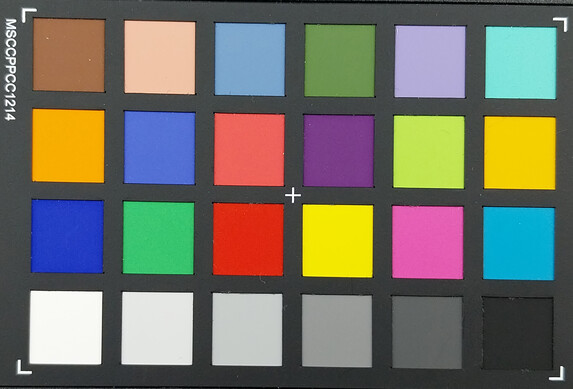
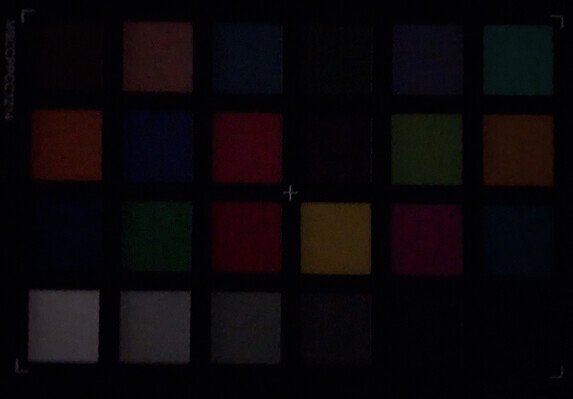
Accessories & Warranty - No charger included
The Galaxy A23 5G does not come with a charger, with the slim box containing only a SIM tool and a USB cable. Samsung's own store only offers a fast charger with 50 watts for around US$ 50. A suitable charger from the manufacturer is available online for just under US$ 10. On the other hand, power adapters from other manufacturers also worked without issue in our tests.
In Germany, Samsung offers a 24-month warranty on its smartphone. This may differ from location to location, so be sure to check with your supplier before buying.
Input Devices & Operation - Good fingerprint reader
The touchscreen and the physical keys of the Galaxy A23 5G work reliably. The adaptive 120 Hz screen makes touchscreen operation very smooth in some situations, but the automatic frame rate adjustment is not always optimal, so there are stutters from time to time.
The fingerprint sensor is integrated into the standby button, which unlocks the device with minimal delay and recognizes the scanned finger very reliably.
Unlocking via facial recognition is also possible. The screen provides ample brightness in the dark, which is usually sufficient to allow the smartphone to recognize the user. However, this is a software solution that analyzes images from the front-facing camera. This can be subject to hacking/manipulation and is thus less secure than a hardware solution with infrared, such as in the iPhone.
Display - Unfortunately not so bright
The PLS screen, with its expanded resolution of 1080p, fits well in this price range, but Motorola proves with its Moto G82 5G that an OLED screen is also possible.
The screen in the Moto phone is also much brighter than in our review sample, which averages 428 cd/m². While this clearly surpasses the predecessor, it is still a moderate value in view of the comparison devices.
Together with the black value, the contrast ratio is only average, which is not exactly conducive to color brilliance.
| |||||||||||||||||||||||||
Brightness Distribution: 86 %
Center on Battery: 447 cd/m²
Contrast: 1442:1 (Black: 0.31 cd/m²)
ΔE ColorChecker Calman: 5.54 | ∀{0.5-29.43 Ø4.79}
ΔE Greyscale Calman: 7.3 | ∀{0.09-98 Ø5}
99.9% sRGB (Calman 2D)
Gamma: 2.03
CCT: 8853 K
| Samsung Galaxy A23 5G PLS, 2408x1080, 6.6" | Samsung Galaxy A22 5G IPS, 2400x1080, 6.6" | OnePlus Nord CE 2 Lite 5G IPS, 2412x1080, 6.6" | Motorola Moto G82 5G OLED, 2400x1080, 6.6" | Huawei Nova 9 SE LCD, 2388x1080, 6.8" | |
|---|---|---|---|---|---|
| Screen | 4% | 8% | 35% | 16% | |
| Brightness middle (cd/m²) | 447 | 415 -7% | 590 32% | 635 42% | 546 22% |
| Brightness (cd/m²) | 428 | 378 -12% | 561 31% | 640 50% | 523 22% |
| Brightness Distribution (%) | 86 | 76 -12% | 92 7% | 96 12% | 93 8% |
| Black Level * (cd/m²) | 0.31 | 0.26 16% | 0.38 -23% | 0.75 -142% | |
| Contrast (:1) | 1442 | 1596 11% | 1553 8% | 728 -50% | |
| Colorchecker dE 2000 * | 5.54 | 5.41 2% | 5.15 7% | 2.96 47% | 0.6 89% |
| Colorchecker dE 2000 max. * | 10.04 | 9.77 3% | 10.35 -3% | 7.63 24% | 1 90% |
| Greyscale dE 2000 * | 7.3 | 4.8 34% | 7.1 3% | 4.8 34% | 0.8 89% |
| Gamma | 2.03 108% | 2.348 94% | 2.143 103% | 2.214 99% | 2.25 98% |
| CCT | 8853 73% | 7748 84% | 8540 76% | 6970 93% | 6540 99% |
* ... smaller is better
Screen Flickering / PWM (Pulse-Width Modulation)
| Screen flickering / PWM not detected | |||
In comparison: 53 % of all tested devices do not use PWM to dim the display. If PWM was detected, an average of 8163 (minimum: 5 - maximum: 343500) Hz was measured. | |||
The first thing we noticed in our measurements with the spectral photometer and the CalMAN software was that the smartphone's brightness sensor didn't always work optimally and occasionally provided too little brightness in bright surroundings.
Our measurements also revealed a clear blue tint and color values that deviated very strongly.
On the other hand, we did not register any PWM flickering, even at very low brightness.
Display Response Times
| ↔ Response Time Black to White | ||
|---|---|---|
| 26 ms ... rise ↗ and fall ↘ combined | ↗ 13 ms rise | |
| ↘ 13 ms fall | ||
| The screen shows relatively slow response rates in our tests and may be too slow for gamers. In comparison, all tested devices range from 0.1 (minimum) to 240 (maximum) ms. » 61 % of all devices are better. This means that the measured response time is worse than the average of all tested devices (20.3 ms). | ||
| ↔ Response Time 50% Grey to 80% Grey | ||
| 18 ms ... rise ↗ and fall ↘ combined | ↗ 10 ms rise | |
| ↘ 8 ms fall | ||
| The screen shows good response rates in our tests, but may be too slow for competitive gamers. In comparison, all tested devices range from 0.165 (minimum) to 636 (maximum) ms. » 31 % of all devices are better. This means that the measured response time is better than the average of all tested devices (31.7 ms). | ||
The smartphone can still be used outdoors on cloudy days, but strong reflections on the screen and the relatively low maximum brightness become a problem in direct sunlight.
Viewing angle stability is good. At most, a slight color shift becomes visible at very flat viewing angles.
Performance - Galaxy A23 5G with solid power
The Qualcomm Snapdragon 695 5G is an SoC from last year that fits well in a budget mid-range device. The Galaxy A23 5G definitely has more power than its predecessor, and the smartphone usually runs smoothly in everyday use.
However, the system is not very responsive after a restart or when a new SIM card is inserted. The performance also reaches its limits with more complex apps, but you can still run many simpler and moderately complex programs without problems.
Even though the display is a 120 Hz panel, you cannot make the 120 Hz setting permanent, which means operation is either smooth or subject to slight delays, depending on the situation.
| CrossMark - Overall | |
| Average of class Smartphone (187 - 2674, n=130, last 2 years) | |
| OnePlus Nord CE 2 Lite 5G | |
| Average Qualcomm Snapdragon 695 5G (521 - 606, n=18) | |
| Motorola Moto G82 5G | |
| Samsung Galaxy A23 5G | |
| AImark - Score v2.x | |
| Samsung Galaxy A22 5G | |
| OnePlus Nord CE 2 Lite 5G | |
| Average Qualcomm Snapdragon 695 5G (4924 - 5839, n=10) | |
| Samsung Galaxy A23 5G | |
| Motorola Moto G82 5G | |
The Galaxy A23 5G's graphics performance is not only on par with its predecessor, but is much faster. So the Adreno 619 does a good job here.
GFXBench (DX / GLBenchmark) 2.7: T-Rex Onscreen | 1920x1080 T-Rex Offscreen
GFXBench 3.0: on screen Manhattan Onscreen OGL | 1920x1080 1080p Manhattan Offscreen
GFXBench 3.1: on screen Manhattan ES 3.1 Onscreen | 1920x1080 Manhattan ES 3.1 Offscreen
GFXBench: on screen Car Chase Onscreen | 1920x1080 Car Chase Offscreen | on screen Aztec Ruins High Tier Onscreen | 2560x1440 Aztec Ruins High Tier Offscreen | on screen Aztec Ruins Normal Tier Onscreen | 1920x1080 Aztec Ruins Normal Tier Offscreen
| 3DMark / Wild Life Extreme Unlimited | |
| Samsung Galaxy A22 5G | |
| Motorola Moto G82 5G | |
| Samsung Galaxy A23 5G | |
| OnePlus Nord CE 2 Lite 5G | |
| Huawei Nova 9 SE | |
| 3DMark / Wild Life Extreme | |
| Motorola Moto G82 5G | |
| OnePlus Nord CE 2 Lite 5G | |
| Samsung Galaxy A23 5G | |
| Huawei Nova 9 SE | |
| Huawei Nova 9 SE | |
| Samsung Galaxy A22 5G | |
| 3DMark / Wild Life Unlimited Score | |
| Motorola Moto G82 5G | |
| OnePlus Nord CE 2 Lite 5G | |
| Samsung Galaxy A23 5G | |
| Samsung Galaxy A22 5G | |
| Huawei Nova 9 SE | |
| 3DMark / Wild Life Score | |
| Motorola Moto G82 5G | |
| OnePlus Nord CE 2 Lite 5G | |
| Samsung Galaxy A23 5G | |
| Samsung Galaxy A22 5G | |
| Huawei Nova 9 SE | |
| 3DMark / Sling Shot Extreme (Vulkan) Unlimited Physics | |
| Motorola Moto G82 5G | |
| Samsung Galaxy A23 5G | |
| OnePlus Nord CE 2 Lite 5G | |
| Samsung Galaxy A22 5G | |
| Huawei Nova 9 SE | |
| 3DMark / Sling Shot Extreme (Vulkan) Unlimited Graphics | |
| Motorola Moto G82 5G | |
| OnePlus Nord CE 2 Lite 5G | |
| Samsung Galaxy A23 5G | |
| Samsung Galaxy A22 5G | |
| Huawei Nova 9 SE | |
| 3DMark / Sling Shot Extreme (Vulkan) Unlimited | |
| Motorola Moto G82 5G | |
| OnePlus Nord CE 2 Lite 5G | |
| Samsung Galaxy A23 5G | |
| Samsung Galaxy A22 5G | |
| Huawei Nova 9 SE | |
| 3DMark / Sling Shot Extreme (ES 3.1) Unlimited Physics | |
| OnePlus Nord CE 2 Lite 5G | |
| Motorola Moto G82 5G | |
| Samsung Galaxy A23 5G | |
| Samsung Galaxy A22 5G | |
| Huawei Nova 9 SE | |
| 3DMark / Sling Shot Extreme (ES 3.1) Unlimited Graphics | |
| Motorola Moto G82 5G | |
| OnePlus Nord CE 2 Lite 5G | |
| Samsung Galaxy A23 5G | |
| Samsung Galaxy A22 5G | |
| Huawei Nova 9 SE | |
| 3DMark / Sling Shot Extreme (ES 3.1) Unlimited | |
| Motorola Moto G82 5G | |
| OnePlus Nord CE 2 Lite 5G | |
| Samsung Galaxy A23 5G | |
| Samsung Galaxy A22 5G | |
| Huawei Nova 9 SE | |
| 3DMark / Sling Shot Extreme (ES 3.1) | |
| Motorola Moto G82 5G | |
| OnePlus Nord CE 2 Lite 5G | |
| Samsung Galaxy A23 5G | |
| Samsung Galaxy A22 5G | |
| Huawei Nova 9 SE | |
| 3DMark / Sling Shot Extreme (ES 3.1) Graphics | |
| Motorola Moto G82 5G | |
| OnePlus Nord CE 2 Lite 5G | |
| Samsung Galaxy A23 5G | |
| Samsung Galaxy A22 5G | |
| Huawei Nova 9 SE | |
| 3DMark / Sling Shot Extreme (ES 3.1) Physics | |
| Motorola Moto G82 5G | |
| Samsung Galaxy A23 5G | |
| OnePlus Nord CE 2 Lite 5G | |
| Samsung Galaxy A22 5G | |
| Huawei Nova 9 SE | |
| GFXBench (DX / GLBenchmark) 2.7 / T-Rex Onscreen | |
| Samsung Galaxy A23 5G | |
| OnePlus Nord CE 2 Lite 5G | |
| Motorola Moto G82 5G | |
| Samsung Galaxy A22 5G | |
| GFXBench (DX / GLBenchmark) 2.7 / T-Rex Offscreen | |
| Motorola Moto G82 5G | |
| OnePlus Nord CE 2 Lite 5G | |
| Samsung Galaxy A23 5G | |
| Samsung Galaxy A22 5G | |
| GFXBench 3.0 / Manhattan Onscreen OGL | |
| Motorola Moto G82 5G | |
| OnePlus Nord CE 2 Lite 5G | |
| Samsung Galaxy A23 5G | |
| Samsung Galaxy A22 5G | |
| GFXBench 3.0 / 1080p Manhattan Offscreen | |
| Motorola Moto G82 5G | |
| OnePlus Nord CE 2 Lite 5G | |
| Samsung Galaxy A23 5G | |
| Samsung Galaxy A22 5G | |
| GFXBench 3.1 / Manhattan ES 3.1 Onscreen | |
| OnePlus Nord CE 2 Lite 5G | |
| Motorola Moto G82 5G | |
| Samsung Galaxy A23 5G | |
| Samsung Galaxy A22 5G | |
| GFXBench 3.1 / Manhattan ES 3.1 Offscreen | |
| Motorola Moto G82 5G | |
| Samsung Galaxy A23 5G | |
| OnePlus Nord CE 2 Lite 5G | |
| Samsung Galaxy A22 5G | |
| GFXBench / Car Chase Onscreen | |
| OnePlus Nord CE 2 Lite 5G | |
| Motorola Moto G82 5G | |
| Samsung Galaxy A23 5G | |
| Samsung Galaxy A22 5G | |
| GFXBench / Car Chase Offscreen | |
| Motorola Moto G82 5G | |
| Samsung Galaxy A23 5G | |
| OnePlus Nord CE 2 Lite 5G | |
| Samsung Galaxy A22 5G | |
| GFXBench / Aztec Ruins High Tier Onscreen | |
| Samsung Galaxy A23 5G | |
| OnePlus Nord CE 2 Lite 5G | |
| Motorola Moto G82 5G | |
| Samsung Galaxy A22 5G | |
| Huawei Nova 9 SE | |
| GFXBench / Aztec Ruins High Tier Offscreen | |
| OnePlus Nord CE 2 Lite 5G | |
| Motorola Moto G82 5G | |
| Samsung Galaxy A23 5G | |
| Samsung Galaxy A22 5G | |
| Huawei Nova 9 SE | |
| GFXBench / Aztec Ruins Normal Tier Onscreen | |
| OnePlus Nord CE 2 Lite 5G | |
| Motorola Moto G82 5G | |
| Samsung Galaxy A23 5G | |
| Samsung Galaxy A22 5G | |
| Huawei Nova 9 SE | |
| GFXBench / Aztec Ruins Normal Tier Offscreen | |
| OnePlus Nord CE 2 Lite 5G | |
| Samsung Galaxy A23 5G | |
| Motorola Moto G82 5G | |
| Samsung Galaxy A22 5G | |
| Huawei Nova 9 SE | |
Internet surfing with the smartphone is quite fast: pages are loaded quickly and images are also displayed rapidly. Of course, there are short waiting times now and then, but these are still within limits.
| Jetstream 2 - 2.0 Total Score | |
| Average of class Smartphone (23.8 - 387, n=154, last 2 years) | |
| Average Qualcomm Snapdragon 695 5G (48.6 - 105.3, n=19) | |
| Samsung Galaxy A23 5G (Chrome 106) | |
| OnePlus Nord CE 2 Lite 5G (Chrome 103.0.5060.129) | |
| Motorola Moto G82 5G (Chrome 102) | |
| Samsung Galaxy A22 5G (Chrome 92) | |
| Speedometer 2.0 - Result 2.0 | |
| Average of class Smartphone (15.2 - 643, n=131, last 2 years) | |
| Average Qualcomm Snapdragon 695 5G (38.7 - 80.1, n=16) | |
| OnePlus Nord CE 2 Lite 5G (Chrome 103.0.5060.129) | |
| Motorola Moto G82 5G (Chome 102) | |
| Samsung Galaxy A23 5G (Chome 106) | |
| Samsung Galaxy A22 5G (Chome 92) | |
| WebXPRT 4 - Overall | |
| Average of class Smartphone (27 - 306, n=147, last 2 years) | |
| Average Qualcomm Snapdragon 695 5G (58 - 111, n=18) | |
| OnePlus Nord CE 2 Lite 5G (Chrome 103.0.5060.129) | |
| Samsung Galaxy A23 5G (Chrome 106) | |
| Motorola Moto G82 5G (Chrome 102) | |
| WebXPRT 3 - Overall | |
| Average of class Smartphone (38 - 380, n=41, last 2 years) | |
| Average Qualcomm Snapdragon 695 5G (75 - 156, n=12) | |
| OnePlus Nord CE 2 Lite 5G (Chrome 103.0.5060.129) | |
| Samsung Galaxy A23 5G (Chrome 106) | |
| Motorola Moto G82 5G (Chrome 102) | |
| Samsung Galaxy A22 5G (Chrome 92) | |
| Octane V2 - Total Score | |
| Average of class Smartphone (2228 - 121337, n=200, last 2 years) | |
| Average Qualcomm Snapdragon 695 5G (17849 - 31647, n=21) | |
| OnePlus Nord CE 2 Lite 5G (Chrome 103.0.5060.129) | |
| Motorola Moto G82 5G (Chrome 102) | |
| Samsung Galaxy A23 5G (Chrome 106) | |
| Samsung Galaxy A22 5G (Chrome 92) | |
| Huawei Nova 9 SE (Huawei Browser 12) | |
| Mozilla Kraken 1.1 - Total | |
| Samsung Galaxy A22 5G (Chrome 92) | |
| Motorola Moto G82 5G (Chrome 102) | |
| Samsung Galaxy A23 5G (Chrome 106) | |
| OnePlus Nord CE 2 Lite 5G (Chrome 103.0.5060.129) | |
| Average Qualcomm Snapdragon 695 5G (1298 - 2501, n=18) | |
| Average of class Smartphone (257 - 28190, n=155, last 2 years) | |
* ... smaller is better
Samsung installs a fast UFS 2.2 storage in the Galaxy A23 5G, which enables much faster transfer rates than the old-fashioned eMMC storage medium in the predecessor.
This is positively noticeable in everyday use thanks to better loading times and data transfer rates.
| Samsung Galaxy A23 5G | Samsung Galaxy A22 5G | OnePlus Nord CE 2 Lite 5G | Motorola Moto G82 5G | Huawei Nova 9 SE | Average 64 GB UFS 2.2 Flash | Average of class Smartphone | |
|---|---|---|---|---|---|---|---|
| AndroBench 3-5 | -48% | -3% | -5% | 40% | 8% | 199% | |
| Sequential Read 256KB (MB/s) | 485.1 | 300.5 -38% | 509.21 5% | 473.4 -2% | 973.13 101% | 770 ? 59% | 2216 ? 357% |
| Sequential Write 256KB (MB/s) | 487.4 | 210.3 -57% | 482.15 -1% | 445.7 -9% | 714.41 47% | 399 ? -18% | 1832 ? 276% |
| Random Read 4KB (MB/s) | 188.2 | 118 -37% | 179.02 -5% | 180.8 -4% | 154.28 -18% | 156.6 ? -17% | 293 ? 56% |
| Random Write 4KB (MB/s) | 163.1 | 69.2 -58% | 147.46 -10% | 155.5 -5% | 211.27 30% | 177.7 ? 9% | 340 ? 108% |
Gaming - Occasionally good frame rates
In gaming, the Samsung smartphone manages around 85 fps in Armajet, even if the frame rates fluctuate considerably. The full 120 Hz can only be utilized in a few cases. In PUBG Mobile at least, we see a stable 40 fps at low settings and 30 fps at high settings. Frame rates were measured with the GameBench software suite.
If you want your gaming fun to be absolutely future-proof and without stutters, you'll likely need to fork out more money, but most mobile games are acceptably playable on Samsung's Galaxy A23 5G.
Emissions - No dramatic heating
Temperature
The smartphone heats up most in the upper right area of the back: we registered up to 43.6 °C here. The waste heat is significantly lower in the lower area. Overall, you can feel the phone getting hot under prolonged load, but it doesn't become critical in mild weather.
System stability is also at a very high level, so the processor doesn't need to throttle and full performance is maintained. This was confirmed in the 3DMark stress test.
(±) The maximum temperature on the upper side is 40.1 °C / 104 F, compared to the average of 35.2 °C / 95 F, ranging from 21.9 to 247 °C for the class Smartphone.
(±) The bottom heats up to a maximum of 43.6 °C / 110 F, compared to the average of 34 °C / 93 F
(+) In idle usage, the average temperature for the upper side is 21.7 °C / 71 F, compared to the device average of 32.9 °C / 91 F.
3DMark Wild Life Stress Test
| 3DMark | |
| Wild Life Stress Test Stability | |
| Samsung Galaxy A23 5G | |
| Huawei Nova 9 SE | |
| OnePlus Nord CE 2 Lite 5G | |
| Motorola Moto G82 5G | |
| Samsung Galaxy A22 5G | |
| Wild Life Extreme Stress Test | |
| OnePlus Nord CE 2 Lite 5G | |
| Motorola Moto G82 5G | |
| Samsung Galaxy A22 5G | |
| Samsung Galaxy A23 5G | |
| Huawei Nova 9 SE | |
Speakers
The Galaxy smartphone's mono speaker does a decent job: maximum volume is good, music sounds reasonably rich, and the trebles are tolerable. But you shouldn't expect deep tones.
Those wanting really good quality sound can use the 3.5 mm jack and Bluetooth 5.1 to connect external audio devices. However, as is usual for Samsung phones, support for aptX Bluetooth codecs is lacking. In exchange, you get Samsung's in-house Scalable Codec. So you should pay attention to compatibility when buying wireless headphones.
Samsung Galaxy A23 5G audio analysis
(+) | speakers can play relatively loud (85.9 dB)
Bass 100 - 315 Hz
(-) | nearly no bass - on average 24.8% lower than median
(±) | linearity of bass is average (11.9% delta to prev. frequency)
Mids 400 - 2000 Hz
(±) | higher mids - on average 9.9% higher than median
(±) | linearity of mids is average (7.8% delta to prev. frequency)
Highs 2 - 16 kHz
(±) | higher highs - on average 9.2% higher than median
(±) | linearity of highs is average (13.5% delta to prev. frequency)
Overall 100 - 16.000 Hz
(±) | linearity of overall sound is average (26.7% difference to median)
Compared to same class
» 67% of all tested devices in this class were better, 6% similar, 27% worse
» The best had a delta of 12%, average was 35%, worst was 134%
Compared to all devices tested
» 81% of all tested devices were better, 4% similar, 15% worse
» The best had a delta of 4%, average was 24%, worst was 134%
Samsung Galaxy A22 5G audio analysis
(+) | speakers can play relatively loud (83.5 dB)
Bass 100 - 315 Hz
(-) | nearly no bass - on average 31.9% lower than median
(±) | linearity of bass is average (10% delta to prev. frequency)
Mids 400 - 2000 Hz
(±) | higher mids - on average 6.3% higher than median
(+) | mids are linear (6.2% delta to prev. frequency)
Highs 2 - 16 kHz
(+) | balanced highs - only 3.8% away from median
(+) | highs are linear (5.8% delta to prev. frequency)
Overall 100 - 16.000 Hz
(±) | linearity of overall sound is average (24.6% difference to median)
Compared to same class
» 58% of all tested devices in this class were better, 7% similar, 35% worse
» The best had a delta of 12%, average was 35%, worst was 134%
Compared to all devices tested
» 74% of all tested devices were better, 6% similar, 21% worse
» The best had a delta of 4%, average was 24%, worst was 134%
Battery Life - Galaxy A23 lasts for a long time
Power Consumption
Under full load, Samsung's Galaxy A23 5G proves to be slightly less energy-hungry than its predecessor, whereas it needs slightly more energy in idle mode. The Galaxy Phone's idle consumption is also quite high in comparison with other devices.
| Off / Standby | |
| Idle | |
| Load |
|
Key:
min: | |
| Samsung Galaxy A23 5G 5000 mAh | Samsung Galaxy A22 5G 5000 mAh | OnePlus Nord CE 2 Lite 5G 5000 mAh | Motorola Moto G82 5G 5000 mAh | Average Qualcomm Snapdragon 695 5G | Average of class Smartphone | |
|---|---|---|---|---|---|---|
| Power Consumption | 5% | 26% | 14% | -2% | -34% | |
| Idle Minimum * (Watt) | 1 | 0.9 10% | 0.8 20% | 0.9 10% | 0.886 ? 11% | 0.856 ? 14% |
| Idle Average * (Watt) | 1.5 | 1.3 13% | 1 33% | 1.2 20% | 1.76 ? -17% | 1.437 ? 4% |
| Idle Maximum * (Watt) | 2 | 1.7 15% | 1.4 30% | 1.4 30% | 1.92 ? 4% | 1.612 ? 19% |
| Load Average * (Watt) | 3.6 | 3.8 -6% | 2.4 33% | 3.3 8% | 3.86 ? -7% | 7.1 ? -97% |
| Load Maximum * (Watt) | 5.3 | 5.8 -9% | 4.6 13% | 5.2 2% | 5.45 ? -3% | 11.2 ? -111% |
* ... smaller is better
Power Consumption: Geekbench (150 cd/m²)
Power Consumption: GFXBench (150 cd/m²)
Battery Life
With its 5,000 mAh battery, the Galaxy A23 5G manages long runtimes, but they do not quite match the predecessor. The differences amount to 5% overall, which shouldn't be too noticeable in everyday use. 18:19 hours in our Wi-Fi translates to several days of operation away from the power outlet, as long as the smartphone is not put under too much strain.
The Galaxy Phone can be charged with a maximum charging power of 25 watts. This is much faster than the predecessor, which only allows a maximum of 15 watts. There is still room for improvement when compared to other manufacturers in this price range, but two hours of charging with a completely empty battery is okay.
| Samsung Galaxy A23 5G 5000 mAh | Samsung Galaxy A22 5G 5000 mAh | OnePlus Nord CE 2 Lite 5G 5000 mAh | Motorola Moto G82 5G 5000 mAh | Huawei Nova 9 SE 4000 mAh | |
|---|---|---|---|---|---|
| Battery runtime | 5% | -10% | -4% | -27% | |
| Reader / Idle (h) | 43.1 | 47.6 10% | 33.1 -23% | 40.9 -5% | |
| H.264 (h) | 21.5 | 21.8 1% | 20.9 -3% | 20.8 -3% | |
| WiFi v1.3 (h) | 18.3 | 19.3 5% | 17.7 -3% | 17 -7% | 13.3 -27% |
| Load (h) | 5.1 | 5.3 4% | 4.6 -10% | 5 -2% |
Pros
Cons
Verdict - Renovated all around, but more expensive
Samsung has improved its affordable Galaxy A23 5G in many areas: faster charging, an even faster screen, more modern storage, optical image stabilization for the camera, greater processing power, and significantly improved usability when traveling thanks to more 4G bands.
However, the price has also increased significantly: You now have to pay US$ 244.99 for the smartphone. On the other hand, the Galaxy A23 5G performs well in this price range. Sure, the case could be more stable, the newly added macro camera is hardly usable due to its low resolution, and the battery life is slightly shorter than in the predecessor. Furthermore, you have to deal with a lot of bloatware in the system and settle for Samsung's own UI.
With the Samsung Galaxy A23 5G, Samsung has renewed its mid-range phone and improved it in many areas. But this comes at an increased price for buyers.
Similarly expensive competitors, for example, are to be found in OnePlus' Nord CE 2 Lite, which loads more quickly and offers more storage. The Motorola Moto G82 5G, for its part, has an OLED screen.
Price and Availability
The Samsung Galaxy A23 5G with 64 GB of storage can be purchased directly via the manufacturer's website online in the USA for US$ 244.99. Interested buyers in other countries are advised to check directly via Samsung, Amazon or any other relevant supplier.
Samsung Galaxy A23 5G
- 10/08/2022 v7 (old)
Florian Schmitt




